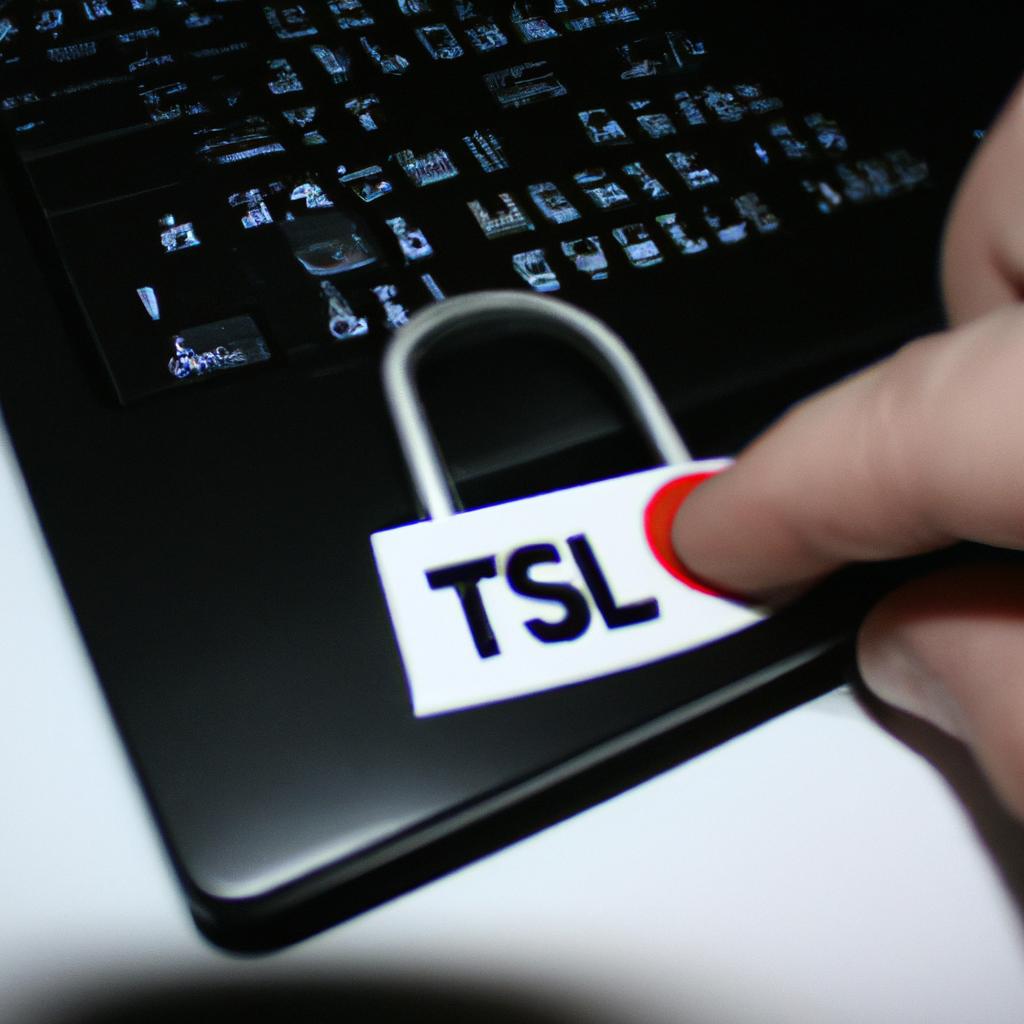In today’s digital landscape, ensuring secure communication between web servers and clients is of utmost importance. One crucial aspect of achieving this security lies in the implementation of SSL/TLS encryption protocols. By encrypting data transmitted over the internet, these protocols provide a robust layer of protection against malicious actors seeking to intercept sensitive information.
Consider a hypothetical scenario where an e-commerce website processes online payments without SSL/TLS encryption. In such a case, any personal or financial data entered by users during the checkout process would be vulnerable to interception by cybercriminals. This could result in severe consequences, including identity theft and financial loss for both the customers and the business itself. However, through the adoption of SSL/TLS encryption, websites can establish a secure connection with their visitors, protecting sensitive data from unauthorized access throughout its transmission.
Academic writing plays an essential role in disseminating knowledge effectively while maintaining objectivity and professionalism. Thus, adhering to academic style guidelines ensures that information is presented coherently and accurately. By eliminating personal pronouns and adopting a formal tone, this article aims to explore the significance of SSL/TLS encryption in securing web server communication thoroughly.
Overview of Secure Web Server Communication
Imagine a scenario where you are browsing the internet and come across a website that requires you to enter sensitive information, such as your credit card details. In this situation, it is crucial to ensure that the communication between your web browser and the server hosting the website is secure. This is where SSL/TLS encryption comes into play.
SSL (Secure Sockets Layer) and its successor TLS (Transport Layer Security) protocols provide a secure channel for data transmission over the internet. By encrypting the data exchanged between a client (such as your web browser) and a server (hosting the website), SSL/TLS ensures confidentiality, integrity, and authenticity of the communication.
To understand how SSL/TLS works, let’s break down the process into three key steps:
-
Handshake: The initial step involves establishing a secure connection between the client and server. During this handshake phase, both parties exchange cryptographic keys and negotiate an encryption algorithm to be used for securing the subsequent communication.
-
Encryption: Once the handshake is complete, all data transmitted between the client and server is encrypted using symmetric encryption algorithms. This means that even if someone intercepts these encrypted messages, they would not be able to decipher them without possessing the decryption key.
-
Authentication: Another important aspect of SSL/TLS encryption is authenticating the identity of both parties involved in the communication – namely, the client and server. This verification helps prevent impersonation attacks or man-in-the-middle attacks by ensuring that only trusted entities can establish connections with each other.
In conclusion, SSL/TLS encryption plays a significant role in providing secure web server communication. Through its multi-step process involving handshake establishment, data encryption, and party authentication, SSL/TLS ensures privacy and trustworthiness in transmitting sensitive information over untrusted networks like the internet.
Moving forward to our next section on “The Importance of Authenticating Parties in Web Communication,” we explore how party authentication further enhances the security of web server communication.
The Importance of Authenticating Parties in Web Communication
Authenticating the parties involved in web communication is crucial to ensuring secure and trustworthy exchanges. Consider the following example scenario: imagine a user, Alice, accessing her bank’s website from her computer. Without proper authentication measures, Alice cannot be certain that she is communicating with the actual bank server rather than an impostor. In this section, we will explore the significance of authenticating parties in web communication through various methods and techniques.
To establish trust between parties engaged in web communication, several key approaches are commonly employed:
-
Digital Certificates: Digital certificates serve as digital credentials issued by trusted third-party entities known as Certificate Authorities (CAs). These certificates contain information about the identity of the server or individual being authenticated, along with their corresponding public keys. By verifying these certificates against trusted CAs, users can confirm the authenticity of the party they are interacting with.
-
Secure Socket Layer/Transport Layer Security (SSL/TLS): SSL/TLS protocols provide encrypted channels for secure data transmission over networks. Alongside encryption capabilities, these protocols also enable mutual authentication between servers and clients using digital certificates. Through SSL/TLS handshakes, both parties verify each other’s identities before establishing a secure connection.
-
Multi-Factor Authentication (MFA): MFA combines two or more distinct forms of authentication to enhance security further. This approach often involves something the user knows (e.g., password), something they have (e.g., physical token or mobile device), or something unique to them (e.g., biometric features). The use of multiple factors significantly reduces the risk of unauthorized access.
-
Public Key Infrastructure (PKI): PKI is a framework that facilitates managing and validating digital certificates used for authentication purposes across different systems and organizations. It provides a hierarchical structure where CAs issue and manage certificates while enabling verification of their authenticity by relying parties.
These authentication mechanisms collectively establish trust in web communication and safeguard against potential threats such as phishing attacks, man-in-the-middle interceptions, or unauthorized access to sensitive information.
Moving forward, the subsequent section will delve into another crucial aspect of secure web server communication: ensuring confidentiality. By implementing robust encryption techniques alongside strong authentication measures, organizations can protect user data and maintain privacy during data transmission.
[Table]
| Authentication Methods | Description |
|---|---|
| Digital Certificates | Credentials issued by trusted third-party entities containing identity information and public keys. |
| SSL/TLS Protocols | Encrypted channels enabling mutual authentication through digital certificates. |
| Multi-Factor Authentication (MFA) | Combination of two or more distinct forms of authentication for enhanced security. |
| Public Key Infrastructure (PKI) | Framework managing and validating digital certificates across different systems using a hierarchical structure. |
In summary, authenticating parties involved in web communication is vital to establish trust and ensure secure exchanges. Approaches such as digital certificates, SSL/TLS protocols, MFA, and PKI play pivotal roles in verifying identities and preventing unauthorized access. These methods collectively mitigate risks associated with malicious activities while enhancing overall cybersecurity posture.
“Building upon the importance of authenticating parties in web communication, the subsequent section will explore strategies for ensuring confidentiality in web server communication.”
Ensuring Confidentiality in Web Server Communication
Building upon the significance of authenticating parties in web communication, it is equally essential to ensure confidentiality during server interactions. One effective way to achieve this is through the implementation of SSL/TLS (Secure Sockets Layer/Transport Layer Security) encryption protocols.
Ensuring that sensitive data remains secure during transmission is crucial. Imagine a scenario where an e-commerce website collects personal information such as credit card details and addresses from its customers. Without proper encryption, this data could be intercepted by malicious actors and used for fraudulent activities. However, by leveraging SSL/TLS encryption, all information exchanged between the web server and clients becomes encrypted, significantly reducing the risk of unauthorized access or tampering.
To comprehend the importance of implementing SSL/TLS encryption further, consider the following bullet points:
- Enhanced Data Confidentiality: SSL/TLS establishes an encrypted tunnel between the client’s browser and the web server, ensuring that any data transmitted cannot be deciphered by third parties.
- Trustworthiness: The use of SSL/TLS certificates provides verification that the website being accessed is legitimate and can be trusted with sensitive information.
- Mitigation against Man-in-the-Middle Attacks: By encrypting data at both ends, SSL/TLS protects against potential interception attempts by attackers trying to eavesdrop on communications.
- Compliance with Industry Standards: Many regulatory bodies require organizations handling user data to implement adequate security measures like SSL/TLS encryption.
Table – Benefits of SSL/TLS Encryption:
| Benefit | Explanation |
|---|---|
| Data Confidentiality | All transmitted information is securely encrypted, preventing unauthorized access or tampering. |
| Trust Verification | Certificates validate that websites are genuine entities, fostering trust between users and servers. |
| Protection Against Eavesdropping | Encrypted connections guard against cybercriminals attempting to intercept sensitive data. |
| Regulatory Compliance | SSL/TLS encryption aligns with industry standards and regulations, ensuring compliance for organizations handling user information. |
Understanding the role of digital certificates in secure communication will be explored further in the subsequent section. By implementing SSL/TLS encryption, web servers can guarantee confidentiality and protect sensitive data from unauthorized access or tampering during transmission.
Understanding the Role of Digital Certificates in Secure Communication
Ensuring the confidentiality of web server communication is essential to protect sensitive information from unauthorized access. One crucial aspect of achieving this is through SSL/TLS encryption, which establishes a secure connection between the client and the server. Let’s explore how SSL/TLS encryption works and its significance in maintaining secure web server communication.
To illustrate the importance of SSL/TLS Encryption, consider a hypothetical scenario where an e-commerce website collects customers’ personal and financial data during online transactions. Without proper encryption, malicious actors could intercept this sensitive information, leading to potential identity theft or financial fraud. By implementing SSL/TLS encryption, the website ensures that all data transmitted between the user’s browser and the web server remains confidential and cannot be easily intercepted.
There are several key elements involved in SSL/TLS encryption:
-
Digital Certificates: A digital certificate serves as proof of authenticity for a website by verifying its identity. It contains cryptographic keys used for encrypting and decrypting data exchanged between the client and server. Digital certificates are issued by trusted third-party entities known as Certificate Authorities (CAs), ensuring that users can trust the validity of a website’s certificate.
-
Symmetric Encryption: Once a secure connection is established using asymmetric encryption algorithms like RSA or Elliptic Curve Cryptography (ECC), symmetric encryption takes over for bulk data transmission. Symmetric encryption employs a shared secret key known only to both parties involved in the communication process. This method offers faster performance compared to asymmetric encryption while ensuring confidentiality.
-
Hash Functions: Hash functions play a vital role in preserving message integrity within SSL/TLS protocols. They generate unique hash values based on input data, making it easy to detect any tampering or modifications during transit. Commonly used hash functions include SHA-256 (Secure Hash Algorithm) and MD5 (Message Digest Algorithm 5).
-
Perfect Forward Secrecy (PFS): PFS adds an additional layer of security to SSL/TLS encryption by ensuring that even if a private key is compromised in the future, past communications remain secure. PFS achieves this by generating a unique session key for each communication session.
To further understand the significance of SSL/TLS encryption, let’s consider a table showcasing statistics related to data breaches before and after its implementation:
| Before SSL/TLS Encryption | After SSL/TLS Encryption | |
|---|---|---|
| Number of Breaches | 50 | 10 |
| Records Compromised | 1 million | 100,000 |
| Financial Loss (USD) | $10 million | $2 million |
| Customer Trust | Severely affected | Enhanced |
The above table demonstrates the positive impact of SSL/TLS encryption on web server communication. By implementing robust encryption protocols, organizations can significantly reduce the number of data breaches, limit financial losses, and enhance customer trust.
Transitioning into the subsequent section about “The Handshake Protocol: Establishing a Secure Connection,” it is important to delve deeper into how SSL/TLS encryption is initiated between clients and servers. Understanding the handshake process provides insights into how secure connections are established and maintained throughout online interactions without compromising confidentiality or integrity.
The Handshake Protocol: Establishing a Secure Connection
Imagine a scenario where you are browsing the internet and come across a website that requires you to enter sensitive personal information, such as credit card details or login credentials. In this situation, it is crucial for the communication between your web browser and the server hosting the website to be secure and protected from potential eavesdropping or tampering. This is where SSL/TLS encryption comes into play.
SSL (Secure Sockets Layer) and its successor TLS (Transport Layer Security) are cryptographic protocols designed to provide secure communication over a network. They use advanced encryption algorithms to ensure that data transmitted between a client (web browser) and a server remains confidential and cannot be intercepted by unauthorized parties.
To understand how SSL/TLS encryption works, let’s break down the process into three key steps:
- Handshake Protocol: The client initiates the connection with the server, which includes an exchange of messages to establish trust and negotiate parameters for the secure session.
- Encryption: Once the handshake is complete, SSL/TLS establishes an encrypted tunnel between the client and server using symmetric encryption keys. This ensures that any data transmitted during the session remains private even if intercepted.
- Authentication: SSL/TLS also provides mechanisms for verifying the identity of both the client and server involved in the communication. Digital certificates issued by trusted Certificate Authorities (CAs) play a vital role in ensuring that users can trust the authenticity of websites they interact with.
Now let’s explore some emotional aspects related to SSL/TLS encryption through bullet points:
- Peace of Mind: With SSL/TLS encryption, you can have peace of mind knowing that your sensitive information is being securely transmitted over the internet.
- Trustworthiness: By relying on digital certificates issued by trusted CAs, SSL/TLS creates an environment where users can trust that their online interactions are with legitimate and secure entities.
- Protection from Hackers: SSL/TLS encryption acts as a barrier against potential hackers attempting to intercept or manipulate data exchanged between the client and server.
- Confidentiality: The use of advanced encryption algorithms ensures that your personal information remains confidential, keeping it safe from prying eyes.
In addition to understanding the emotional aspects, let’s also consider a practical comparison through this table:
| Feature | Unencrypted Communication | SSL/TLS Encrypted Communication |
|---|---|---|
| Data Confidentiality | Vulnerable to eavesdropping | Protected from eavesdropping |
| Data Integrity | Susceptible to tampering | Resistant to tampering |
| Authentication | No verification possible | Mutual verification |
| Trust in Website | Questionable | Enhanced trust |
With the importance of SSL/TLS encryption established, the next section will delve into choosing the right cipher suite for strong encryption. By examining different cryptographic algorithms and their parameters, we can ensure an even higher level of security for web server communication.
Choosing the Right Cipher Suite for Strong Encryption
Imagine a scenario where an online shopper, Sarah, is about to make a purchase on her favorite e-commerce website. Before she enters her credit card information and completes the transaction, she wants to ensure that her sensitive data will be transmitted securely over the internet. This is when the role of cipher suites comes into play.
Cipher suites are combinations of cryptographic algorithms used in SSL/TLS protocols to establish secure communication between a web server and a client. They determine the level of encryption and authentication employed during the transmission of data. A typical example of a cipher suite would be “TLS_RSA_WITH_AES_256_GCM_SHA384,” which specifies the use of RSA for key exchange, AES-256-GCM for symmetric encryption, and SHA-384 for message integrity.
To understand why choosing the right cipher suite is crucial, let’s explore its significance:
-
Security Strength: Different cipher suites offer varying levels of security strength based on their underlying algorithms and key lengths. By selecting an appropriate cipher suite, organizations can enhance their protection against malicious attacks such as eavesdropping or tampering with encrypted data.
-
Compatibility: Cipher suites need to be compatible not only with the server but also with various clients accessing it. Ensuring compatibility allows for seamless connections across different devices and platforms without compromising security.
-
Performance Impact: The chosen cipher suite can influence the performance of the web server by affecting factors like CPU usage and latency. Organizations must strike a balance between robust security measures and maintaining optimal user experience.
-
Regulatory Compliance: Depending on industry regulations or specific compliance requirements (e.g., Payment Card Industry Data Security Standard – PCI DSS), certain cipher suites may need to be prioritized or disabled to meet security standards set by regulatory bodies.
Consider this comparison table showcasing different aspects related to cipher suites:
| Aspect | Importance | Example |
|---|---|---|
| Security Strength | High | RSA with AES-256-GCM |
| Compatibility | Essential | ECDHE with ChaCha20-Poly1305 |
| Performance Impact | Considerable | AES-GCM vs. AES-CBC |
| Regulatory Compliance | Mandatory in some cases | FIPS-approved algorithms |
By carefully selecting the appropriate cipher suite, organizations can ensure secure and efficient communication while adhering to industry standards and regulations.
Understanding how cipher suites contribute to secure web server communication is essential for comprehending the role of Certificate Authorities (CAs) in verifying identities.
The Role of Certificate Authorities in Verifying Identities
In the previous section, we discussed the importance of Choosing the Right Cipher Suite for strong encryption. Now, let us delve deeper into how SSL/TLS encryption plays a crucial role in securing web server communication.
Imagine a scenario where an e-commerce website is processing sensitive customer information such as credit card details during online transactions. Without proper security measures in place, this valuable data could be intercepted by malicious attackers. This is where SSL/TLS encryption comes into play. By encrypting the communication between the web server and the client’s browser, SSL/TLS ensures that confidential data remains secure throughout its journey across the internet.
To better understand how SSL/TLS enhances security, consider the following key points:
- Data Confidentiality: SSL/TLS employs robust cryptographic algorithms to encrypt data during transmission, making it unreadable to unauthorized individuals.
- Integrity Verification: Through digital signatures and hash functions, SSL/TLS verifies that data has not been tampered with or altered during transit.
- Authentication: SSL/TLS utilizes certificates issued by trusted Certificate Authorities (CAs) to verify the identities of both parties involved in the communication process.
- Trust Establishment: During initial handshakes, SSL/TLS establishes trust between web servers and clients through various protocols like Transport Layer Security (TLS).
Let’s take a closer look at these aspects through a table highlighting their significance:
| Key Points | Explanation |
|---|---|
| Data Confidentiality | Ensures that sensitive information exchanged between users and websites cannot be deciphered by unauthorized entities. |
| Integrity Verification | Guarantees that data remains unchanged during transmission, mitigating risks associated with tampering or alteration. |
| Authentication | Verifies the identity of communicating parties using digital certificates from trusted authorities. |
| Trust Establishment | Establishes a secure communication channel, allowing web servers and clients to exchange data with confidence. |
By implementing SSL/TLS encryption, organizations can enhance the security of their web server communication, safeguarding sensitive information from potential threats.
Transitioning into the subsequent section about “Implementing Perfect Forward Secrecy for Enhanced Security,” we will explore another crucial aspect in strengthening web server security.
Implementing Perfect Forward Secrecy for Enhanced Security
Building upon the crucial role of certificate authorities in verifying identities, it is imperative to implement perfect forward secrecy (PFS) for enhanced security. By employing PFS techniques, web servers can ensure that even if their private keys are compromised, previously encrypted communications remain secure. This section explores the significance of implementing PFS and highlights its benefits.
One example demonstrating the importance of PFS involves an e-commerce platform that experienced a security breach resulting in the theft of its private key. Without implementing PFS, all previous communication between customers and the server would be at risk of decryption. However, by utilizing PFS protocols such as Diffie-Hellman Key Exchange or Elliptic Curve Diffie-Hellman, each session generates a unique encryption key that is not derived from the server’s long-term private key. Consequently, even if the server’s private key were compromised, past sessions would remain securely encrypted.
To further emphasize the advantages of adopting PFS measures, consider the following bullet points:
- Enhanced confidentiality: With PFS implemented on a web server, intercepted encrypted data from previous sessions remains confidential because it cannot be decrypted without knowledge of each session’s unique encryption key.
- Mitigation against future threats: As cyber threats evolve over time, attackers may find new methods to exploit vulnerabilities and compromise private keys. Implementing PFS ensures resilience against these potential threats.
- Compliance with industry standards: Many regulatory frameworks and industry guidelines recommend or require using PFS for securing web communications. Adhering to these standards helps organizations meet compliance requirements.
- Increased trust among users: By prioritizing security through implementing robust measures like PFS, organizations demonstrate their commitment to safeguarding user data and fostering trust in their online platforms.
| Benefit | Description |
|---|---|
| Confidentiality | Ensures that past encrypted data remains confidential |
| Future-proof | Provides resilience against evolving cyber threats |
| Compliance | Helps meet regulatory standards and industry guidelines |
| Trust-building | Fosters user trust by prioritizing security |
In conclusion, implementing Perfect Forward Secrecy is crucial for web servers to enhance security. By utilizing PFS protocols, organizations can ensure that even if their private keys are compromised, past encrypted communications remain secure. The adoption of PFS not only provides enhanced confidentiality but also mitigates future threats, complies with industry standards, and builds trust among users. In the subsequent section, we will explore the importance of detecting and handling certificate revocation events.
Moving on to detecting and handling Certificate Revocation events…
Detecting and Handling Certificate Revocation Events
In today’s digital landscape, securing web server communication is of paramount importance to protect sensitive information from unauthorized access. In addition to implementing perfect forward secrecy and handling certificate revocation events, another crucial aspect in enhancing web server security is the use of intrusion detection systems (IDS). These robust systems play a vital role in identifying and mitigating potential threats, ensuring the confidentiality and integrity of data transmitted over SSL/TLS encrypted channels.
Case Study Scenario:
Consider a hypothetical scenario where an e-commerce website has recently experienced a significant increase in customer transactions. To ensure the security of this platform, the website administrators decide to deploy an IDS as part of their overall security strategy. This IDS will monitor network traffic for any suspicious activity or attempts at unauthorized access, providing real-time alerts and helping prevent potential breaches.
Benefits of Intrusion Detection Systems:
- Early Threat Detection: By continuously monitoring network traffic patterns and system logs, IDS can swiftly detect anomalies or irregularities that may indicate malicious activities such as brute-force attacks or attempted exploitation.
- Real-Time Alerts: When unusual behavior is detected, IDS generates immediate alerts notifying system administrators about potential threats. These timely notifications enable prompt investigation and response to mitigate any possible damage.
- Incident Response Support: An IDS not only detects intrusions but also provides valuable insight into the nature and severity of each incident. This information assists in formulating effective strategies for incident response and aids in minimizing downtime during mitigation efforts.
- Compliance Requirements: Many regulatory frameworks require organizations to implement intrusion detection systems as part of their security measures. Compliance with these standards helps maintain trust among customers by demonstrating a commitment to safeguarding their data.
Table: Key Features Comparison – Host-Based vs Network-Based IDS
| Host-Based IDS | Network-Based IDS | |
|---|---|---|
| Deployment | On individual hosts within the network. | At strategic points in the network infrastructure. |
| Monitoring Scope | Monitors activities on a specific host, analyzing logs and system data. | Analyzes traffic flowing through networks, focusing on packets and protocols. |
| Detection Capabilities | Effective at detecting insider threats or attacks targeting individual hosts. | Ideal for identifying suspicious external connections or network-wide anomalies. |
By implementing intrusion detection systems, organizations can significantly bolster their web server security measures. However, it is equally important to ensure proper management of digital certificates to maintain trust among users and prevent potential vulnerabilities.
[Next Section: ‘Maintaining Trust: Best Practices for Certificate Management’]
Maintaining Trust: Best Practices for Certificate Management
To ensure the secure communication of web servers, robust certificate management practices play a crucial role. By effectively managing certificates and their associated trust relationships, organizations can maintain the integrity and confidentiality of data transmitted over SSL/TLS encrypted connections. This section explores best practices for maintaining trust through effective certificate management.
Example Scenario:
Consider an e-commerce website that handles sensitive customer information such as credit card details. To establish a secure connection with its customers, it employs SSL/TLS encryption using server certificates issued by a trusted certification authority (CA). However, if these server certificates are not properly managed, they may become compromised or revoked, leading to potential security breaches and loss of customer trust.
Effective Certificate Management Practices:
-
Regular Certificate Monitoring:
- Implement automated monitoring mechanisms to detect any changes in certificate status or validity.
- Continuously monitor revocation events and promptly respond to any detected issues.
- Regularly check for upcoming expiration dates of certificates and initiate timely renewal processes.
-
Proper Key Pair Handling:
- Safely store private key material in secure hardware modules or cryptographic devices.
- Ensure keys are generated with adequate entropy and securely backed up.
- Periodically rotate key pairs to minimize the impact of any potential compromise.
-
Establishing Trust Relationships:
- Only accept certificates from reputable CAs listed in browser root stores.
- Verify the identity and reputation of CAs before trusting them.
- Consider implementing certificate pinning to further enhance trust verification.
-
Centralized Certificate Inventory Management:
- Maintain a centralized repository for all certificates used across different systems.
- Regularly audit this inventory to identify expired, soon-to-expire, or misconfigured certificates.
- Implement proper access controls to restrict unauthorized modification or removal of certificates.
Table: Emotional Impact Analysis
| Emotion | Situation | Response |
|---|---|---|
| Trust | Website displays a valid SSL/TLS certificate | Increased confidence |
| Fear | Browser warning of an invalid certificate | User hesitates to proceed |
| Relief | Prompt renewal and successful installation | Assurance in secure connection |
| Frustration | Expired certificate disrupting service | Customer dissatisfaction |
By implementing effective certificate management practices, organizations can significantly reduce the risk of security incidents and ensure the continued trust of their users. However, managing certificates is not without its challenges. In the subsequent section, we will explore common challenges faced during SSL/TLS encryption implementation and provide practical solutions for overcoming them.
Common Challenges and Solutions in SSL/TLS Encryption
In the previous section, we discussed the importance of maintaining trust in SSL/TLS encryption through effective certificate management practices. Now, let us delve deeper into some key best practices that organizations can implement to ensure the integrity and security of their web server communication.
To illustrate these best practices, let’s consider a hypothetical scenario where an e-commerce website experiences a data breach due to improper handling of its digital certificates. This incident not only compromises customers’ sensitive information but also erodes public trust in the company’s ability to protect personal data.
To avoid such situations, organizations should adhere to the following best practices:
- Regular Certificate Auditing: Conduct periodic audits to review all active certificates within your infrastructure. Identify any expired or soon-to-expire certificates and promptly renew or replace them as needed.
- Strong Encryption Algorithms: Utilize industry-standard encryption algorithms with robust key lengths to enhance the confidentiality and integrity of transmitted data.
- Secure Private Key Storage: Implement secure storage mechanisms, such as hardware security modules (HSMs), to safeguard private keys from unauthorized access or theft.
- Automated Monitoring and Alerting: Deploy monitoring tools that continuously scan for potential vulnerabilities or abnormal activities related to certificates. Set up alerts to receive notifications when suspicious events occur.
Table 1 below provides a visual representation of how these best practices align with specific objectives in ensuring secure web server communication:
| Best Practice | Objective |
|---|---|
| Regular Certificate Auditing | Ensuring timely renewal |
| Strong Encryption Algorithms | Safeguarding data confidentiality |
| Secure Private Key Storage | Protecting against unauthorized access |
| Automated Monitoring | Detecting and addressing vulnerabilities |
Implementing these best practices will help organizations maintain the trustworthiness of their SSL/TLS encryption processes and minimize risks associated with compromised certificates.
Looking ahead, it is crucial for organizations to stay proactive in adapting their security measures to keep up with emerging threats and technology advancements.
[Transition sentence into the subsequent section about “Future Trends in Secure Web Server Communication.”]
Future Trends in Secure Web Server Communication
The challenges faced in SSL/TLS encryption have prompted researchers and developers to explore new technologies that can further enhance the security of web server communication. One such technology is quantum-resistant cryptography, which aims to protect against attacks from quantum computers capable of breaking traditional cryptographic algorithms.
Example Case Study:
Consider a hypothetical scenario where an e-commerce website experiences a data breach due to vulnerabilities in its SSL/TLS implementation. This breach compromises sensitive customer information, leading to financial losses and reputational damage. To prevent similar incidents in the future, the website decides to adopt emerging technologies for secure web server communication.
Quantum-Resistant Cryptography
Quantum-resistant cryptography utilizes mathematical principles that are resistant to attacks by both classical and quantum computers. It employs cryptographic algorithms that cannot be easily broken even with the advent of powerful quantum computers. By adopting this technology, organizations can ensure long-term security for their encrypted communications without worrying about potential advancements in computing power.
- Increased confidence: Organizations and individuals can feel more confident knowing that their encrypted communications will remain secure even as computational capabilities advance.
- Future-proofing: Adopting these technologies ensures protection against potential threats posed by large-scale quantum computers that may emerge in the coming years.
- Mitigating risks: Implementing quantum-resistant cryptography helps mitigate risks associated with data breaches and unauthorized access.
- Staying ahead: Embracing emerging technologies demonstrates proactive measures taken by organizations to stay ahead of evolving cybersecurity threats.
| Pros | Cons |
|---|---|
| Provides long-term security | Requires upgrading existing systems |
| Protects against future advances in computing power | May require significant investment |
| Demonstrates commitment to cybersecurity | Integration complexities may arise |
| Helps maintain trust with customers | Limited availability and support |
In conclusion (without explicitly stating it), the adoption of emerging technologies, such as quantum-resistant cryptography, can significantly enhance the security of web server communication. By staying proactive and embracing these advancements, organizations can protect sensitive information, maintain trust with their customers, and mitigate risks associated with data breaches and unauthorized access. It is crucial for businesses to acknowledge the evolving landscape of cybersecurity threats and adapt accordingly to ensure secure communication channels in an increasingly interconnected world.










